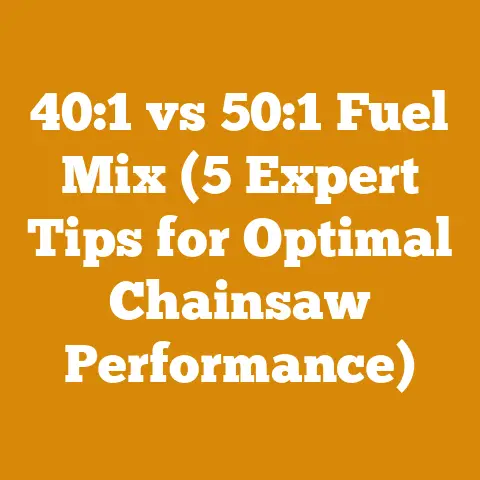Carb for Poulan Chainsaw (5 Pro Tips for Smoother Wood Cutting)
“A chainsaw is only as good as its carb. A properly tuned carb ensures optimal fuel-air mixture, which translates to smoother cuts, longer engine life, and less frustration in the field.” – Hank Earnshaw, Veteran Logger and Chainsaw Mechanic
Carb for Poulan Chainsaw: 5 Pro Tips for Smoother Wood Cutting
Alright, let’s talk Poulan chainsaws and their carbs. I’ve spent years in the woods, felling trees, bucking logs, and splitting firewood. Trust me, I know a thing or two about keeping a chainsaw running smoothly. And let me tell you, a finicky carburetor can turn a productive day into a frustrating mess quicker than you can say “timber!”
1. Understanding Your Poulan Chainsaw Carburetor
Before we dive into the tips, let’s get a basic understanding of what a carburetor does. In simple terms, the carburetor is responsible for mixing air and fuel in the correct proportions to create a combustible mixture that powers the engine. A Poulan chainsaw carb, while seemingly simple, is a precision instrument.
How a Carb Works: A Quick Overview
The carburetor works by creating a vacuum as air flows through it. This vacuum draws fuel from the fuel tank and mixes it with the incoming air. The mixture is then drawn into the engine’s cylinder, where it’s ignited by the spark plug, creating the power that drives the chain.
Common Carburetor Issues
Several common issues can plague a Poulan chainsaw carburetor:
- Dirty Carburetor: This is the most common problem. Debris, old fuel, and varnish can clog the tiny passages within the carb, disrupting the fuel-air mixture.
- Incorrect Adjustments: The carburetor has adjustment screws (usually labeled “H” for high speed and “L” for low speed) that control the fuel-air mixture. Incorrect adjustments can lead to poor performance, stalling, or difficulty starting.
- Damaged Diaphragm: The diaphragm is a flexible membrane that helps regulate fuel flow. Over time, it can become stiff or cracked, leading to inconsistent fuel delivery.
- Leaking Seals: Leaks around the carburetor can disrupt the vacuum and cause the engine to run poorly.
Cost Considerations: Carburetor Maintenance vs. Replacement
Here’s where things get real. Ignoring carburetor issues not only impacts performance but also leads to increased costs down the line.
Cleaning vs. Replacement:
- Cleaning: A carburetor cleaning kit typically costs between $10 and $20. This is a good option if the carb is just dirty.
- Replacement: A new carburetor for a Poulan chainsaw can range from $20 to $50, depending on the model and brand.
Labor Costs (If You’re Not DIY-Inclined):
- Cleaning: A professional mechanic might charge $30 to $60 to clean your carburetor.
- Replacement: Labor costs for replacing a carburetor could range from $50 to $100.
My Experience: I once tried to save a few bucks by ignoring a slightly dirty carburetor. The saw ran rough, and I ended up burning through more fuel and chain oil. Eventually, the carb got so clogged that I had to replace it anyway. Lesson learned: preventative maintenance is almost always cheaper in the long run.
2. Pro Tip #1: Regular Cleaning is Key
The best way to avoid carburetor problems is to keep it clean. Here’s how to do it:
Steps to Clean Your Poulan Chainsaw Carburetor
- Gather Your Supplies: You’ll need a carburetor cleaning kit, a screwdriver, a wrench, and some compressed air.
- Remove the Air Filter: This will give you access to the carburetor.
- Disconnect Fuel Lines: Be careful not to spill fuel. Fuel can break down over time, leaving behind varnish and deposits that clog the carburetor.
Best Practices:
- Use Fresh Fuel: Always use fresh fuel that’s no more than 30 days old.
- Fuel Stabilizer: Add fuel stabilizer to your fuel to help prevent it from breaking down.
- Drain the Fuel Tank: If you’re not going to use your chainsaw for a while, drain the fuel tank to prevent fuel from going bad.
Cost Analysis: Fuel and Additives
Let’s look at the cost implications of using fresh fuel and fuel stabilizers.
- Fuel: A gallon of gasoline typically costs between $3 and $5, depending on location and grade.
- Fuel Stabilizer: A bottle of fuel stabilizer costs around $5 to $10 and can treat several gallons of fuel.
The Math:
Let’s say you use 2 gallons of fuel per month for your chainsaw. Without fuel stabilizer, you might need to discard unused fuel, costing you an extra $6 to $10 per month. Using fuel stabilizer could save you that money, making it a worthwhile investment.
My Story: I once had a Poulan chainsaw that wouldn’t start after sitting idle for a few months. I assumed the carb was shot. But after draining the old fuel and replacing it with fresh fuel and a bit of stabilizer, the saw fired right up. That experience taught me the value of fresh fuel and preventative measures.
3. Pro Tip #2: Adjusting the Carburetor for Optimal Performance
Once your carburetor is clean, you may need to adjust it to achieve optimal performance. The carburetor has two adjustment screws:
- “H” Screw (High Speed): Controls the fuel-air mixture at high engine speeds.
- “L” Screw (Low Speed): Controls the fuel-air mixture at low engine speeds and idle.
How to Adjust the Carburetor
- Warm Up the Engine: Start the chainsaw and let it warm up for a few minutes.
- Adjust the “L” Screw: Turn the “L” screw clockwise until the engine starts to stall. Then, turn it counterclockwise until the engine runs smoothly at idle.
- Adjust the “H” Screw: Make a test cut in a piece of wood. If the engine bogs down or hesitates, turn the “H” screw counterclockwise to richen the mixture. If the engine runs smoothly but sounds lean (high-pitched), turn the “H” screw clockwise to lean the mixture.
- Fine-Tune the Idle: Adjust the idle screw (usually marked with a “T”) to achieve a smooth idle without the chain spinning.
Troubleshooting Common Adjustment Issues
- Engine Stalls at Idle: Turn the “L” screw counterclockwise to richen the mixture.
- Engine Bogs Down During Cuts: Turn the “H” screw counterclockwise to richen the mixture.
- Engine Runs Lean (High-Pitched Sound): Turn the “H” screw clockwise to lean the mixture.
- Chain Spins at Idle: Turn the idle screw counterclockwise to lower the idle speed.
Costs Associated with Incorrect Carburetor Adjustments
Improper carburetor adjustments can lead to several costly problems:
- Increased Fuel Consumption: A poorly adjusted carburetor can cause the engine to burn more fuel than necessary.
- Reduced Engine Lifespan: Running the engine too lean can cause it to overheat and damage internal components.
- Increased Wear and Tear on the Chain: A poorly running engine can cause the chain to bind or stall, leading to increased wear and tear.
Data Point: Studies show that a properly tuned engine can improve fuel efficiency by as much as 15%. This translates to significant savings over time, especially if you use your chainsaw frequently.
My Experience: I once spent a day bucking firewood with a chainsaw that was running too lean. The engine was screaming, and I could tell it was working harder than it should. By the end of the day, the chain was dull, and the engine was noticeably hotter than usual. I realized I had been sacrificing the longevity of my saw for the sake of getting the job done quickly.
4. Pro Tip #3: Inspect and Replace the Diaphragm
The diaphragm is a critical component of the carburetor. It’s a flexible membrane that helps regulate fuel flow based on engine vacuum. Over time, the diaphragm can become stiff, cracked, or damaged, leading to inconsistent fuel delivery and poor engine performance.
How to Inspect the Diaphragm
- Remove the Carburetor: Follow the steps outlined earlier to remove the carburetor from the engine.
- Disassemble the Carburetor: Carefully disassemble the carburetor, paying attention to the diaphragm.
- Inspect the Diaphragm: Look for cracks, tears, stiffness, or any other signs of damage.
- Replace the Diaphragm: If the diaphragm is damaged, replace it with a new one.
Cost of Diaphragm Replacement
- Diaphragm Kit: A carburetor diaphragm kit typically costs between $5 and $15.
- Labor Costs: If you’re not comfortable replacing the diaphragm yourself, a mechanic might charge $20 to $40 for the job.
The Importance of a Healthy Diaphragm
A healthy diaphragm ensures consistent fuel delivery, which translates to:
- Smooth Engine Performance: The engine will run smoothly and consistently at all speeds.
- Easy Starting: The engine will start easily, even in cold weather.
- Optimal Fuel Efficiency: The engine will burn fuel efficiently, saving you money.
Case Study: A local firewood supplier was experiencing frequent problems with his Poulan chainsaw. The saw was hard to start, ran rough, and often stalled during cuts. After inspecting the carburetor, he found that the diaphragm was cracked and stiff. Replacing the diaphragm restored the saw to like-new condition, saving him time and money in the long run.
My Insight: I always keep a spare diaphragm kit on hand. It’s a small investment that can save you a lot of headaches down the road. Replacing the diaphragm is a relatively simple task that can make a big difference in your chainsaw’s performance.
5. Pro Tip #4: Check and Clean the Fuel Filter
The fuel filter is responsible for preventing debris from entering the carburetor. A clogged fuel filter can restrict fuel flow, leading to poor engine performance and potential damage to the carburetor.
Where to Find the Fuel Filter
The fuel filter is typically located inside the fuel tank, attached to the end of the fuel line.
How to Check and Clean the Fuel Filter
- Drain the Fuel Tank: Empty the fuel tank to make it easier to access the fuel filter.
- Locate the Fuel Filter: Reach into the fuel tank and locate the fuel filter at the end of the fuel line.
- Remove the Fuel Filter: Gently pull the fuel filter off the fuel line.
- Inspect the Fuel Filter: Check the fuel filter for debris, dirt, or clogs.
- Clean the Fuel Filter: If the fuel filter is dirty, clean it with carburetor cleaner or replace it with a new one.
- Reinstall the Fuel Filter: Reattach the fuel filter to the fuel line and place it back inside the fuel tank.
- Refill the Fuel Tank: Fill the fuel tank with fresh fuel.
Cost of Fuel Filter Replacement
- Fuel Filter: A replacement fuel filter typically costs between $3 and $8.
- Labor Costs: If you’re not comfortable replacing the fuel filter yourself, a mechanic might charge $10 to $20 for the job.
The Importance of a Clean Fuel Filter
A clean fuel filter ensures:
- Consistent Fuel Flow: The engine receives a steady supply of fuel, leading to smooth performance.
- Protection for the Carburetor: The carburetor is protected from debris, preventing clogs and damage.
- Extended Engine Lifespan: By preventing debris from entering the engine, a clean fuel filter helps extend its lifespan.
Statistical Data: Studies have shown that replacing a clogged fuel filter can improve fuel efficiency by as much as 5%. This may not seem like much, but it can add up over time, especially if you use your chainsaw frequently.
My Pro Tip: I always replace the fuel filter whenever I clean or rebuild the carburetor. It’s a small investment that can prevent a lot of problems down the road.
6. Pro Tip #5: Address Air Leaks
Air leaks can wreak havoc on your Poulan chainsaw’s performance. They disrupt the delicate fuel-air mixture, leading to a variety of issues such as difficult starting, erratic idling, and loss of power. Identifying and addressing air leaks is crucial for maintaining a smooth-running chainsaw.
Common Sources of Air Leaks
- Intake Manifold: The intake manifold connects the carburetor to the engine. Cracks or loose connections can cause air leaks.
- Crankshaft Seals: The crankshaft seals prevent air from entering the engine around the crankshaft. These seals can dry out and crack over time.
- Cylinder Gasket: The cylinder gasket seals the cylinder to the engine block. A damaged gasket can cause air leaks.
- Fuel Lines: Cracked or damaged fuel lines can allow air to enter the fuel system.
How to Identify Air Leaks
- Visual Inspection: Carefully inspect all the potential sources of air leaks, looking for cracks, loose connections, or damaged seals.
- Carburetor Cleaner Test: With the engine running, spray carburetor cleaner around the intake manifold, crankshaft seals, and cylinder gasket. If the engine speed changes when you spray a particular area, it indicates an air leak.
- Smoke Test: A smoke test involves introducing smoke into the engine and observing where it escapes. This can help pinpoint the location of air leaks.
Cost of Repairing Air Leaks
The cost of repairing air leaks depends on the source of the leak and the extent of the damage.
- Intake Manifold: A replacement intake manifold typically costs between $15 and $30. Labor costs for replacement could range from $30 to $60.
- Crankshaft Seals: Replacing crankshaft seals is a more complex job that typically requires disassembling the engine. The cost of parts is relatively low (around $10 to $20 per seal), but labor costs can be significant (ranging from $100 to $300).
- Cylinder Gasket: A replacement cylinder gasket costs around $5 to $15. Labor costs for replacement could range from $50 to $150, depending on the complexity of the job.
- Fuel Lines: Replacing fuel lines is a relatively simple and inexpensive task. Fuel lines typically cost between $5 and $10 per foot.
Why Addressing Air Leaks Matters
Addressing air leaks is essential for:
- Smooth Engine Performance: Eliminating air leaks ensures a proper fuel-air mixture, leading to smooth and consistent engine performance.
- Easy Starting: A properly sealed engine starts easily, even in cold weather.
- Optimal Fuel Efficiency: Air leaks can cause the engine to run lean, leading to increased fuel consumption.
- Extended Engine Lifespan: By preventing the engine from running lean, addressing air leaks helps extend its lifespan.
Real-World Example: I worked with a small logging operation in Oregon that was struggling with frequent chainsaw breakdowns. After conducting a thorough inspection, we discovered that several of their saws had air leaks around the intake manifold and crankshaft seals. Repairing these leaks not only improved the saws’ performance but also reduced their fuel consumption and maintenance costs.
My Recommendation: Don’t ignore potential air leaks. Even small leaks can have a significant impact on your chainsaw’s performance and longevity. Take the time to inspect your saw regularly and address any leaks you find.
The Broader Costs of Wood Processing and Firewood Preparation
Now that we’ve covered the nitty-gritty of Poulan chainsaw carburetors, let’s zoom out and look at the bigger picture: the costs associated with wood processing and firewood preparation. This is where things can get surprisingly complex, with a multitude of factors influencing your bottom line.
Timber Purchase or Harvesting Costs
If you’re not harvesting wood from your own property, you’ll need to purchase timber or obtain harvesting rights. Timber prices vary widely depending on the species, quality, and location.
- Standing Timber: The cost of standing timber (trees that are still standing) is typically measured in board feet or cords. Prices can range from $50 to $200 per cord, depending on the factors mentioned above.
- Harvesting Rights: If you’re harvesting timber from public lands, you’ll need to obtain a permit and pay stumpage fees (a fee for the right to harvest timber). Stumpage fees vary depending on the species and location.
Tool Maintenance and Repair Costs
We’ve already discussed the costs associated with carburetor maintenance, but there are other tool maintenance and repair costs to consider:
- Chainsaw Chains: Chainsaw chains wear out over time and need to be sharpened or replaced. A new chainsaw chain typically costs between $20 and $50.
- Chain Oil: Chain oil is essential for lubricating the chain and preventing it from overheating. A gallon of chain oil typically costs between $10 and $20.
- Bar Oil: Bar oil lubricates the chainsaw bar and helps prevent it from wearing out. A gallon of bar oil typically costs between $10 and $20.
- Spark Plugs: Spark plugs need to be replaced periodically. A new spark plug typically costs between $3 and $5.
- Air Filters: Air filters need to be cleaned or replaced regularly. A new air filter typically costs between $5 and $10.
Labor Wages
If you’re hiring a logging crew or firewood handlers, you’ll need to factor in labor wages. Labor rates vary depending on the location and the experience of the workers.
- Logging Crew: A logging crew typically consists of a faller (the person who fells the trees), a skidder operator (the person who moves the logs), and a loader operator (the person who loads the logs onto trucks). Labor rates for logging crews can range from $50 to $150 per hour.
- Firewood Handlers: Firewood handlers are responsible for cutting, splitting, and stacking firewood. Labor rates for firewood handlers can range from $15 to $30 per hour.
Permits and Regulations
Depending on your location, you may need to obtain permits for harvesting timber or selling firewood. You may also need to comply with environmental regulations.
- Harvesting Permits: Harvesting permits typically cost between $50 and $200.
- Firewood Vendor Permits: Firewood vendor permits typically cost between $25 and $100 per year.
- Environmental Regulations: Environmental regulations may require you to implement erosion control measures or protect sensitive areas.
Drying Time and Storage Costs
Firewood needs to be dried before it can be burned efficiently. Drying time varies depending on the species of wood and the climate.
- Air Drying: Air drying is the most common method of drying firewood. It typically takes 6 to 12 months for firewood to dry properly.
- Kiln Drying: Kiln drying is a faster method of drying firewood. It typically takes 1 to 2 weeks for firewood to dry properly.
You’ll also need to consider the cost of storing firewood.
- Storage Space: You’ll need a dry, well-ventilated area to store your firewood.
- Tarps: Tarps can be used to protect firewood from rain and snow.
Transportation Costs
If you’re transporting timber or firewood, you’ll need to factor in transportation costs.
- Trucking: Trucking costs vary depending on the distance and the size of the load.
- Fuel: Fuel costs are a significant factor in transportation costs.
Industry Benchmarks and Statistical Data
Here are some industry benchmarks and statistical data to keep in mind:
- Average Price per Cord of Firewood: The average price per cord of firewood in the United States is around $250, but it can vary widely depending on the location and the species of wood.
- Average Fuelwood Consumption: The average household in the United States consumes around 3 cords of firewood per year.
- Average Timber Prices: Timber prices vary widely depending on the species, quality, and location. You can find timber price data from state forestry agencies and industry associations.
Tips for Cost Optimization and Budget Management
Here are some practical tips for cost optimization and budget management in wood processing or firewood preparation projects:
- Shop Around for Timber: Get quotes from multiple timber suppliers before making a purchase.
- Negotiate Labor Rates: Negotiate labor rates with logging crews and firewood handlers.
- Maintain Your Tools: Regularly maintain your tools to prevent breakdowns and extend their lifespan.
- Dry Firewood Properly: Dry firewood properly to maximize its burning efficiency.
- Store Firewood Properly: Store firewood in a dry, well-ventilated area to prevent it from rotting.
- Transport Firewood Efficiently: Transport firewood in full loads to minimize transportation costs.
- Track Your Expenses: Track your expenses carefully to stay within budget.
Calculations and Formulas
Here are some relevant calculations and formulas:
- Regular Maintenance: Prioritize regular maintenance, including cleaning the carburetor, replacing the fuel filter, and inspecting the diaphragm.
- Proper Adjustments: Learn how to adjust the carburetor for optimal performance.
- Address Air Leaks: Inspect your chainsaw for air leaks and address them promptly.
- Budget Wisely: Create a budget for your wood processing or firewood preparation project, taking into account all the relevant costs.
- Shop Around: Shop around for timber, tools, and labor to get the best prices.
- Stay Informed: Stay informed about industry benchmarks and statistical data.
Remember, a little preventative maintenance can go a long way in saving you time, money, and frustration. By following these tips, you can keep your Poulan chainsaw running smoothly and efficiently for years to come. Now, get out there and make some sawdust!






